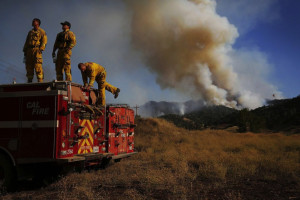By Hannah Payne for EDRblog.org.

As I write this blog, 13,000 Californians are evacuating their homes to escape wildfires, which are spreading with unprecedented speed due to extremely dry conditions after five years of drought. Here in Utah, much of the state continues to experience drought conditions and water restrictions on the Virgin River have been put in place due to low flow for the second summer in a row. And on the other side of the country, coastal towns on the Atlantic coast are struggling to manage rising sea levels.
Climate-related risks like these are not entirely new. Policymakers, natural resource managers, landowners, and communities have had to prepare for and rebound from fires, hurricanes, and droughts before. But climate change is increasing many of these risks—leading to prolonged drought, faster-spreading fires, rising sea levels, and more intense storms.
What makes climate-related risks unique is that they are collective risks. We all win or we all fail together. Many individual choices can either increase or decrease the risks to an entire community and it is the sum of these choices that determine the overall risk. For example, the combination of individual choices to use more or less water during a drought will impact the availability of water for everyone in the region. Your choice to conserve water does not guarantee your future water supply if everyone else in the system continues to consume excessive amounts.
Collective risks must be addressed collectively. Communities will need to bring together diverse stakeholders to determine the best ways to manage local climate-related risks, such as how to manage water usage in times of drought or how to regulate development in order to minimize wildfire risk. And because climate risks do not map cleanly to jurisdictional boundaries, effective risk management will require collaboration and coordination between cities, regions, and state and federal agencies, in order to increase system-wide resilience.
I know that to many, “resilience” is a buzzword without much meaning, but I have found it to be a helpful principle to frame climate risk management. I choose to think about it in the manner defined by the ecologist, C.S. Holling, “Resilience determines the persistence of relationships within a system and is a measure of the ability of these systems to absorb changes.”[1] Our communities are a set of interconnected social, economic, physical, and environmental systems and our choices and policies have the potential to bolster these systems to better absorb climate-related changes.
In order to accomplish this, we will need to think beyond our typical, segregated decision-making structure and move towards collaborative problem solving which engages multiple levels of governance. We will need everyone—business leaders, activists, scientists, institutions, religious communities, and policy makers at local, state and federal levels—to work on building a resilient future that helps our economy, environment, and culture to absorb changes and still persist.
While this is new territory, it is promising that many regions have already started collaboratively planning for climate change and climate-related risks. One such example is the Southeast Florida Climate Compact, which was established as a coordinating entity to align climate change response across county lines in southeast Florida. The compact established regionally consistent public outreach messaging and methodologies for mapping impacts and determining vulnerabilities. Working together, the compact developed a Regional Climate Action Plan to unify strategies for climate change mitigation and adaptation. Other regions, including Los Angeles and Colorado are also building regional networks to address climate change across sectors and municipalities.
Within Utah, it is exciting to see Salt Lake City and the Wasatch Front joining this effort and beginning to tackle climate change risks collectively. A new network is in the works that will bring leaders from Salt Lake City, Park City, Alta, the University of Utah, non-profits, federal agencies, and other regional players together to share knowledge and coordinate climate change mitigation and adaptation strategies. While still in its infancy, the group shows promise in leading the Wasatch Front towards building a networked, regional resilience. Hopefully in the coming years we will see current collaborations strengthen and new partnerships emerge to collectively manage the risks of climate change and to plan for a more resilient future.
 Hannah Payne is summer student fellow with the Stegner Center’s Environmental Dispute Resolution Program. She is currently pursuing a Master of City Planning degree at Massachusetts Institute of Technology (MIT), focusing on environmental policy and planning. Her work this summer is supported by the MIT Public Service Center
Hannah Payne is summer student fellow with the Stegner Center’s Environmental Dispute Resolution Program. She is currently pursuing a Master of City Planning degree at Massachusetts Institute of Technology (MIT), focusing on environmental policy and planning. Her work this summer is supported by the MIT Public Service Center
[1] Holling, CS. (1973). “Resilience and Stability of Ecological Systems.” Annual Review of Ecology and Systematics: 4. 1-23.
